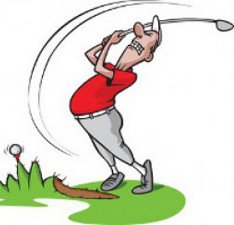
The golf swing is complex, to say the least. Even the best golfers rarely reach a state where they're playing without consciously thinking about the swing – and such states are usually short-lived.
Unconscious golf is ideal, but carrying one or two simple thoughts into every shot is more realistic. Golfers run into major trouble when the mind gets distracted by more than a couple of swing keys. And when you're playing poorly, thoughts can pile up like cars in a freeway crash.
This state is often called “paralysis by analysis” or “analysis paralysis.” You're thinking about so many different swing elements – “rotate the shoulders,” “make a wide arc,” “lead the downswing with the hips” – you get tied up in knots. Some golfers stand over the ball for 10, 20, 30 seconds or more, unable to pull the club back. When they finally swing, they often wish they hadn't.
It's a battle everyone fights at one time or another. The question is, how do you beat paralysis by analysis?
Not with more analysis, that's for sure.
If you're shackled by an overload of mechanical thoughts, try these helpful tips to break free:
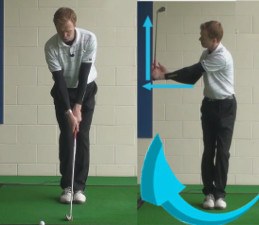
- Drop all expectations: Why do we get so wrapped up in the swing's every minute movement? Because we care. Golfers want to hit the ball long and straight, to score well, to beat (and impress) their playing partners. But it's possible to care too much. When things head south, we start a desperate search for answers. With each subsequent poor swing, we get more and more tense. Our friends offer their advice, adding to the pile. At a certain point, your best bet is to forget about it. The ball goes where it goes and you score what you score. Don't just lower your expectations – drop them altogether. Once your mind is free, your body will follow.
- Focus on tempo: Over-analysis causes the muscles to tighten; the swing becomes stiff and mechanical. If this symptom strikes on the course, step aside with a club, place your feet close together and make a continuous series of smooth half-swings while keeping your balance. Use this as your practice swing for the rest of the round. Some golfers find that keeping a slow, mellow song in their head evens out their tempo. If you've got a favorite, punch it up on your mental MP3 player and hum along. Whatever works, right?
- Develop a swing trigger: If you simply can't get comfortable enough to take the club back, you need a trigger to get started. This is usually a brief, nearly imperceptible move that signals your body to get moving. Many pros use a swing trigger. For example, Jack Nicklaus cocked his head to the right just before takeaway (a move he borrowed from Sam Snead). Others kick the right knee inward, or press the hands forward. A trigger serves to clear the mind and get the swing started the same way, every time. If you find yourself in a jumble of thoughts, just pull the trigger and bang, away you go.
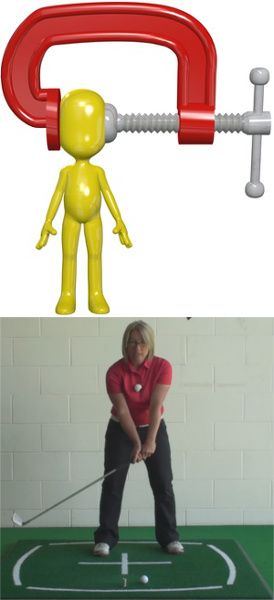
Tips for Beating Paralysis by Analysis
There is a lot you can choose to analyze in the game of golf. If you would like, you can dive deep into swing theory, thinking about how to move each part of your body as the club swings back and through. Or, you can think in-depth on the topic of course management, going into painstaking detail to decide which clubs to use, and which targets to pick. While there is nothing wrong with thinking your way around the course – and, indeed, you will need to think plenty if you wish to play good golf – you need to be careful to avoid something known as 'paralysis by analysis'.
Those who suffer from paralysis by analysis on the course are basically overthinking the game. By trying too hard to make the perfect decisions and the perfect swing, these players are 'getting in their own heads', preventing themselves from playing up to their maximum ability level. Ideally, you will find a way to straddle the line between too much analysis and not enough. You do have to think critically on the course in order to play well, but taking that sort of thinking a step too far can lead to ugly consequences.
In this article, we are going to provide tips which will hopefully help you to steer clear of this frustrating condition. Fortunately, getting back on track and teaching your brain to work the right way on the course is a relatively simple task. Sure, it may take some time to have the lessons provided below actually lead to results, but this is not something that should take years to pay off. Get to work right away on improving the way you think on the course and your scores should benefit sooner rather than later.
If you do suffer from paralysis by analysis in your current golf game, you may be comforted to know that many professionals have dealt with this issue through the years. With so much on the line each time they play, many pros are tempted to break down and analyze even the smallest aspects of the game. This might seem like a good idea at the time, but it usually leads to disappointing results – for pros and amateurs alike. Golf is not an 'effort game', meaning that you don't necessarily play better just because you try harder. To play well on the golf course, you have to execute a specific set of skills at a high level. Trying harder and analyzing your every move is only going to lead to frustration, so do your best to avoid going down that road.
As an amateur golfer, you should have a couple of specific goals in mind anytime you head to the course. For one, you will want to play well. Everyone enjoys shooting a good score, regardless of skill level. Some players consider a good score to be something in the 70s, while others are happy to stay under 100. Whatever your personal goals happen to be, posting a good score is always a welcome development. So, in addition to playing well, what is your other goal during each round? To have fun. That might sound simplistic and even childish, but it is important. Golf is a game, and you are not playing for a paycheck out there. If you overanalyze the game, you will make it hard to hit on either one of these goals. You will be unlikely to play well, and you probably won't have that much fun in the process. Strip away your unnecessary layers of analysis, keep the game as simple as possible, and have a great time while shooting some quality scores.
All of the content below is based on a right-handed golfer. If you happen to play left-handed, please take a moment to reverse the directions as necessary.
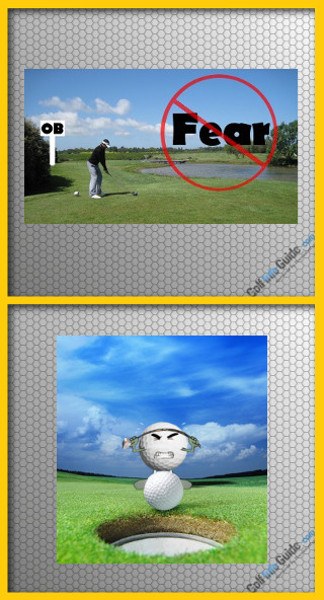
Paralysis by Analysis Warning Signs
To fix any problem, you have to first know that the problem exists. That can be a significant hurdle when it comes to the topic of this article. You probably don't know that analysis is having a paralyzing effect on your golf game, since you are used to playing golf this way. It just seems like you are going about your business as usual on the course, so nothing appears to be out of place. However, if you look carefully, you may find that some of the classic paralysis by analysis warning signs are already present in your game.
The list below includes three common signs which point to overthinking the game of golf.
- Difficulty getting the swing started. This is the leading sign of paralysis by analysis, and it is one that catches up to nearly every golfer at one point or another. The problem is simple – you get over the ball, you take your stance, and then you find it difficult (or impossible) to get the swing started. Your brain is hard at work trying to decide how to start the swing, and the overwhelming number of thoughts in your head wind up crashing together and nothing happens in the end. Not only does this issue make it hard to play good golf, it can be embarrassing as well. You might find yourself having to explain to your playing partners why you have been standing over the ball for so long before hitting each shot. This is such an important piece of the paralysis by analysis puzzle that we have dedicated an entire section to this topic later in the article.
- Taking too long to play. If you are always the one who is lagging behind in your group, or you always seem to be holding up the golfers behind you, there is a good chance you are thinking too much on the course. Slow play is a major problem in the game of golf, as it has actually driven some players away from the game for good. While golf was never meant to be a fast game, it should be played at a reasonable speed from the first hole on through to the last. Of course, you can't keep up a good pace if you are too busy thinking about every last little detail in your game. To speed things up, try simplifying the way you think about your game once you are on the course. If you are going to deeply analyze your golf swing, save that work for the range when you won't be holding anyone else up.
- Missing short putts. You might think that missing short putts is simply the result of a poor stroke, but often this problem is indicative of a bigger issue. Should you find that you consistently miss short putts during your rounds, it may be that you are overthinking those putts – and everything else, for that matter. All golfers will miss from short range on occasion, so don't become too worried if you have a couple putts slide by the edge. However, if this problem becomes a pattern, it will be necessary to think carefully about why you are struggling with the flat stick from short range.
The presence of any of these three warning signs should give you cause for concern regarding your game as a whole. Once these issues settle into your game, they will become habits that are harder and harder to break as time goes by. Your best course of action is to address the matter right away. By dealing with these problems quickly, you should be able to get back on track without much trouble.
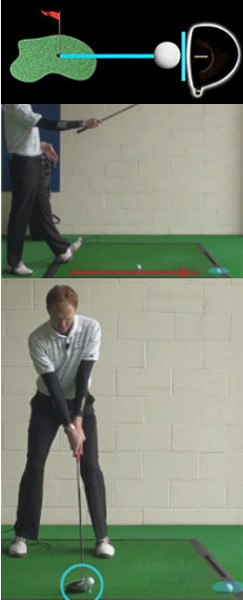
Don't Get Stuck
As mentioned in the previous section, getting stuck at address is a common, yet extremely frustrating, problem related to paralysis by analysis. If you are thinking too much before starting your swing, the swing may not start at all – you may find yourself stuck over the ball, staring down at the ground while trying to figure out how to get your body to move. This is a weird feeling, it is embarrassing, and it certainly will not lead to good golf.
To get over this problem, you are going to need a plan. First, you will need to build a quality pre-shot routine. If you have a routine which you perform prior to every shot, you will put yourself in a more comfortable frame of mind. Familiarity often breeds confidence, so learn to use the same routine before all of your shots in order to avoid doubting your ability just before starting the swing.
As part of your pre-shot routine, you will want to have a specific plan for what you are going to do when standing over the ball. To get you pointed in the right direction, we have provided some step by step directions below.
- In the early stages of your pre-shot routine, you need to go through tasks such as determining your yardage, picking the right club, selecting a specific target, and more. Also, you may wish to make a practice swing, or visualize your upcoming shot before you hit it.
- Once you are actually standing over the ball, you want to waste very little time before you actually hit the shot. With your stance taken, find a spot on the ball which you will watch throughout the swing. You are going to use this spot to make sure that you don't look up early before the ball has been struck.
- Next, take one last look up at the target. When looking toward the target, be sure not to lift up your head or shoulders in the process. Simply turn your head so you can see the target without affecting the rest of your stance. Once you have taken a final look at the target, turn your head back down toward the ball and locate the spot on the ball you are using for your point of focus.
- As soon as your eyes find that spot, start the swing. There should be no hesitation at this point of the process. If you wait around before starting the swing, you are only going to get into trouble. Use the visual cue of finding your focus spot on the ball as a trigger to start the swing. When your eyes hit that point after looking at the target, the club starts in motion without any delay.
Of course, you will need to practice this process on the range before you use it on the course. It will take a bit of practice to get used to the rhythm which is required to use this method, but it should lead to great results after a bit of work. Best of all, you won't have to worry about getting stuck over the ball since you are starting the swing so quickly. The time you use to spend worrying about the details of your swing will have been taken away. Not only should your results improve, you will also be a faster golfer on the course, which the other players in your group are sure to appreciate.
It is important to think of this process as something that has an even, smooth tempo from start to finish. You don't want to take too long over the ball, but you don't want to rush either. Find your own personal tempo and work through the steps evenly, leading up to a confident and controlled swing.

Proper Preparation is Key
One of the best ways to avoid paralysis by analysis is to properly prepare yourself for the challenges you will face on the course. If you have created a swing which is up to the task of hitting good shots, you won't have much to worry about – and you probably won't find yourself overthinking the game as a result. The combination of solid technique and high confidence is hard to beat on the course, and you can create that combination by spending plenty of time on the practice range.
Practicing the correct way is going to be important in this process. Specifically, you need to make sure there is time in your practice session to just hit some shots without thinking about any technical points. If you are always thinking technically while on the range, those technical thoughts are going to follow you onto the course – where they can cause problems. Don't let that happen. Start out your practice sessions by working on specific technique points, but end by just hitting shots naturally. At the end of each range visit, hit shots where you just pick a target and let it fly. No mechanical thinking, and no analysis of any kind. Just react to the target and send the ball on its way. Adding this type of practice to your routine is going to help pull you away from the analytical side of the game.
The preparation you do during your practice sessions should extend beyond your full swing. You should be hitting plenty of short game shots as well, as the short game makes up approximately half of your shots during the average round. The goal of your practice sessions should be to prepare yourself for every possible shot you could encounter on the course. That may not quite be possible, but you can strive to get as close as you can. Your mind is going to kick into overdrive when you encounter something on the course that you didn't expect to see – by limiting the number of times that happens, you can keep your thinking to a minimum while just playing the game naturally.
One other point on preparation – when warming up prior to a round, you should keep mechanical thoughts as far away from your brain as possible. There is a reason this is called a 'warm up' as opposed to a 'practice session'. You should not be practicing 15 minutes before you walk to the first tee. When you visit the range, you are simply warming up your muscles and finding a bit of rhythm before starting. If you use this time to actually practice your technique, you are going to be thinking too much about your swing when the round begins. Stick to simply warming up before your rounds and leave the practice for days when you aren't going to be hitting the links.

Making Good Decisions
We have talked throughout this article about how you don't want to think too much on the course. That's great – but you do have to do some thinking to get from the first tee to the last green. There are plenty of decisions to be made, and those decisions can't be ignored. So how do you make your decisions as necessary without going into information overload? The tips in this section should help you refine your on-course decision making process.
- You are always right. When on the course, you need to take the attitude that you are always right when it comes to the decisions you make. While that might not always be true, it is important to take such an attitude. If there is any doubt in the back of your mind as to the quality of your decisions, that doubt will show through in your performance. Be confidence, believe in yourself completely, and trust that your decisions are going to work out for the best. Even a poor decision can actually work out okay if you believe that you have made the right call.
- Error on the conservative side. It is always tempting to try the risky, potentially rewarding shots you find on the course. Unfortunately, playing aggressive golf will come back to bite you more often than not. Sure, you can 'go for it' from time to time, but most of the time your choices should be on the conservative side. Playing conservative golf is going to keep your ball in play throughout the day, meaning penalty strokes will stay off your card. You might think playing safe is the boring way to go, but there is nothing boring about adding up a low score at the end of the round.
- Be specific with your targets. It isn't good enough to simply aim for the 'middle of the fairway', or the 'left side of the green'. Instead, you should be dialed in on extremely specific targets which you can use to guide your swings. Pick out spots which are small yet easy to spot, and then do everything you can to hit those targets. This kind of thinking will give you a very focused objective for every swing, which will help to prevent your mind from wandering into areas of unnecessary analysis.
- Stop and think. In the middle of the flow of a round of golf, it is easy to get distracted by other things which may be going on. You might be caught up in conversation with your playing partners. Or, you might be frustrated by the slow play of the group in front of you. Whatever the case, you need to remember to stop and think before each shot you hit. Make a plan, focus on the job in front of you, and then execute. This step alone is likely to save you strokes in your very next round.
Golf should be fun, but there is nothing fun about feeling paralyzed by the amount of analysis which is going into each and every shot. The golfers who get the most out of their games are able to find a good balance between planning their swings and overthinking the game. It may take some practice, but you can walk this line effectively with the help of the tips offered in this article. Once your paralysis by analysis has been cast aside, you can get back to having fun with the game you love. And, as an added benefit, you will almost certainly shoot lower scores in the process. With lower scores to look forward to and the enjoyment of playing relaxed golf, you will hardly be able to wait for your next tee time to roll around. Good luck!






